
OR
We urge India to accept the truth: FM Gyawali
Published On: May 24, 2020 10:37 PM NPT By: Subhash Ghimire/Guna Raj Luitel
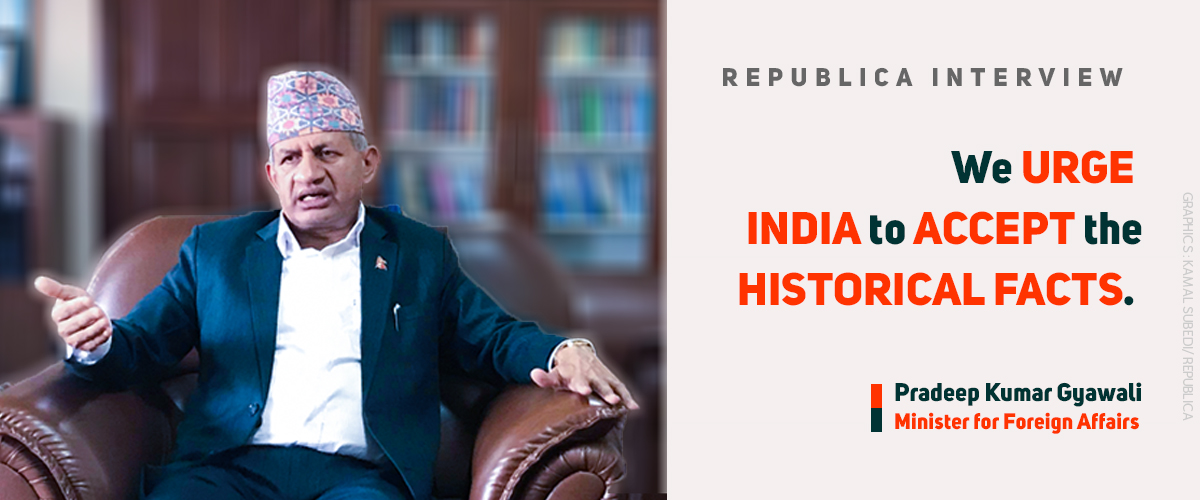
- We have two neighbors, and we cannot and will not close our doors to one and open to another
- This is history’s unresolved, pending and outstanding issue
- History has entrusted us to rid of our baggage
Nepal has said that Kalapani, Lipu Lekh and Limpiyadhura, currently controlled by India, are her territories. Although Nepal has been raising the border issue for years, it has now created a diplomatic stand-off between the two countries. This began after India published a revised political map in November 2019 that included Kalapani, Lipu Lekh and Limpiyadhura in its territories. Nepal strongly objected to the move. The issue took a new turn earlier this month when India's Minister of Defence Rajnath Singh inaugurated the 80-kilometre Lipu Lekh road that Nepal maintained passes through her territory. In response, Nepal published a new map that includes Kalapani, Lipu Lekh and Limpiyadhura. How will the two countries resolve this decades-long issue that has taken Nepal-India relations to a new low? Republica’s Subhash Ghimire and Nagarik’s Gunraj Luitel sat for an extensive conversation with Foreign Minister Pradeep Kumar Gyawali at his office in Singha Durbar on Saturday.
Now that we have issued a new map, how will this border issue with India end?
We have always said that the only way to resolve this issue is by negotiating in good faith. Without impulse or unnecessary excitement, and without prejudice, Nepal wants to resolve the border issues via dialogues.
This border dispute is not new. This is history’s unresolved, pending and outstanding issue that we inherited. This is a baggage, and the sooner we resolve this, the quicker we can set our sights to the future.
Nepal wants to have a relationship based on trust and free of ups and downs, predictable friendly relations. We know that we do not have an alternative to this. So, all our efforts have been to conclude the history’s baggage. We are confident that the only way to resolve the issue is via diplomatic talks and negotiations.
After Nepal published the new map, have there been high level phone conversations or contacts with India?
We have been trying to do that. However, formal talks and conversations have not taken place yet. But different channels are actively working. The Indian side is also deeply concerned and feels the responsibility to address the issue. We feel that when we read between the lines in Indian media. Saner heads in India have urged their government to play a constructive role to end the border disputes with Nepal. We are hopeful that our formal and informal channels of communication will yield something positive.
The 80 kilometers road from Dharchula to the Lipu Lekh pass has been under construction for years. Why didn’t the successive governments do anything on this?
When India and China decided to open that road in 2015, we objected to the decision based on three logic. First, the tri-junction point has not been identified in that area, and so we objected to that bilateral agreement to use the Nepali soil without our consent. Second, we repeatedly told both the countries that the land is ours. This did not borne out of emotion, but was based on historical facts and evidence. Third, when India published its new political map on November 2, 2019 showing Nepali land on its map we protested the decision. We requested for talks multiple times. We even sent two sets of possible dates for talks to New Delhi, but there was no response.
We also communicated via other channels. And then South Asia was engulfed by the pandemic by the end of March. We have claimed that the territory is ours, and the historical facts prove our point. We then sent a diplomatic note to both India and China in 2015 and to India in 2019, protesting their decisions to use Nepali soil without our consent. We had expected a status-quo in the area. That was our expectation back then. No one had expected that the road project would be inaugurated, virtually, in the midst of this pandemic. We have questioned the validity of the road and protested accordingly, and so Nepal’s position is clear on this.
Some in the Indian media say the move by New Delhi to inaugurate the road is a subtle counter to Nepal cozying up to China in recent years.
This is the Indian media’s paranoia. India has a longer border with China than with Nepal. India and China have more than $80 billion annual trade. Our trade volume is small. We protested the Lipu Lekh decision in 2015. India and China have been working to open up Nathula pass and another pass to directly connect with each other. Therefore, questions on Nepal-China relations, especially in the Indian media, are driven by prejudice and paranoia.
We have two neighbors, and we cannot and will not close doors to one to open to another. This has been our established position since the ages. For us, both the neighbors are of equal importance. However, our relations with the two countries are multifaceted. They have different dynamics, and cannot be replaced one by another.
We have always said that we will not allow our land to be used against our neighbors. We have shown this in our actions as well. Managing more than 1,880 kilometers of open border with India is not an easy task. However, we have done everything to address valid security concerns of both the countries. We have also told both of our neighbors that we are extremely sensitive to their security concerns, and that they can be confident of our promise.
These are facts. But those who promote any other narrative of Nepal either have no clue of the historical fact that we are a sovereign, independent and a country that was never-colonized or there are some other concerns that they direct them to a small neighbor like us.
I totally reject the idea of dragging other countries in border disputes between Nepal and India. We had disputes with China on Lipu Lekh, and the issue is still pending.
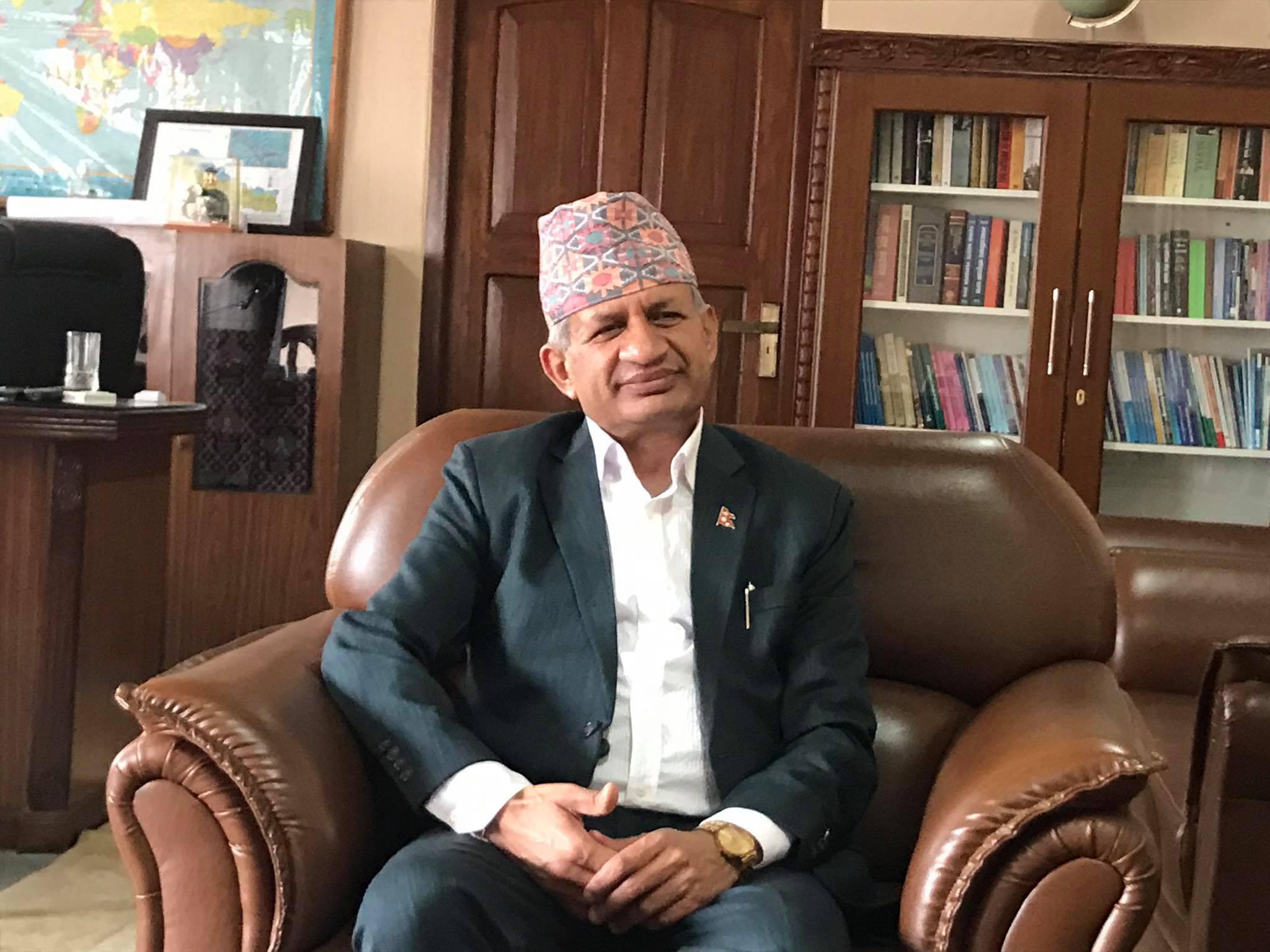
What can be China’s role in the current border dispute between Nepal and India?
We have clearly stated our position on the issue to both India and China. Without Nepal’s presence and permission, we won't accept such agreements. Lipu Lekh is Nepal’s territory. The tri-junction is at some distance in the west. We request both of our neighbors to understand this fact.
This is a bilateral issue, and Nepal and India should resolve this. But at some point, the three countries will have to sit for talks. After we announce the Nepal-India border, then we have to work on finalizing the tri-junction point. But that comes at a later date.
What will happen to the 80 kilometers of road that India has constructed?
We have told them to accept, and respect the historical facts. The only treaty to determine Nepal-India border is the 1816 Treaty of Sugauli. It has three supplementary treaties: 1860 and 1875 and a small change in 1920 during the construction of Sharada Barrage where we swapped lands. But none of these treaties change the fact that Nepal’s western border is the Kali river.
The Treaty of Sugauli never perceives boundary points other than the rivers. The British India made cartographic changes, manipulated and then started to misinterpret them. First there was no dispute over the origin of the Kali river, which actually originates from Limpiyadhura. Any other interpretation of the origin of the river is the manipulation of facts, and it does not have any legal justification. Borders are based on bilateral treaties.
After the cartographic changes, India started to occupy the land. The Indian army has been in Kalapani for many years. The rulers of the time permitted them to stay there for a particular purpose. But without treaties, temporary or forcefully enforced presence do not establish legitimate and legal claim on lands. The argument that we are there and therefore that land is ours has no meaning.
Sometimes we feel that the Indian side wants to make an argument on the border dispute as a fait accompli, which Nepal will not accept. Nepal will not accept border changes that we have not signed. That is why the Indian force has to respectfully return from Kalapani and accept the origin of the Kali river as Limpiyadhura.
Do we have historical records of Indians asking for permission to stay in Kalapani?
We do not have such records. But if we look at the events of the time: the India-China war of 1962 to a new autocratic system in Nepal, where people were not in a position to talk about such issues, India took advantage of the situation. However, those do not establish India’s legality on our land.
Do we have the original copy of the Treaty of Sugauli?
Nepal has submitted a certified copy of the Treaty to the United Nations in 1955. And Nepal was unanimously granted a UN membership during the time. The documents we submitted validate our international borders.
Why didn’t Nepal discuss the Kalapani issue during the time of Mahakali treaty?
I think it was a serious weakness on our part to sign the Mahakali Treaty without confirming the origin of the river. The Integrated Mahakali Treaty accepts river Mahakali as our international border. This is more than 6,000 MWs of hydro project and an agreement on water distribution between the two countries. When we talk of water distribution, we also need to talk of its catchment area. We should have discussed these issues back then.
We formed a joint-technical committee in 1981, and started to scientifically mark our borders: from erecting pillars to clearing Das Gaja. Then the committee could not resolve Kalapani and Susta issues. When Indian prime minister IK Gujral visited Nepal in 1997, the two prime ministers issued a joint statement, where they have accepted Kalapani and Susta as unresolved issues. The two prime ministers directed a technical committee to address the issue. A joint statement of the time reads: “Boundary matters have continuously featured in the high level discussions between Nepal and India.” During the official visit of the prime minister of India to Nepal in 1997, the two prime ministers “directed the joint working group constituted by a joint technical committee to examine the relevant facts relating to the demarcation of the boundary alignment in the western sector, including the Kalapani area and to propose, if necessary, further measures in this regard”.
In 2005, when the joint technical team reached to Garvyang, the Indian security personnel stopped Nepali team to go further up. That was a joint team, but the Indian team did not come. The Nepali team was not allowed to go further up for surveys even after multiple requests. The joint team then presented a report in 2007, stating that Kalapani and Susta were unresolved issues.
When Indian PM Narendra Modi visited Nepal in 2014, it was agreed that a foreign secretary mechanism would resolve this issue. That is why even India has accepted this as a pending and unresolved issue. The developments afterwards have ignored and sidelined the relevant facts.
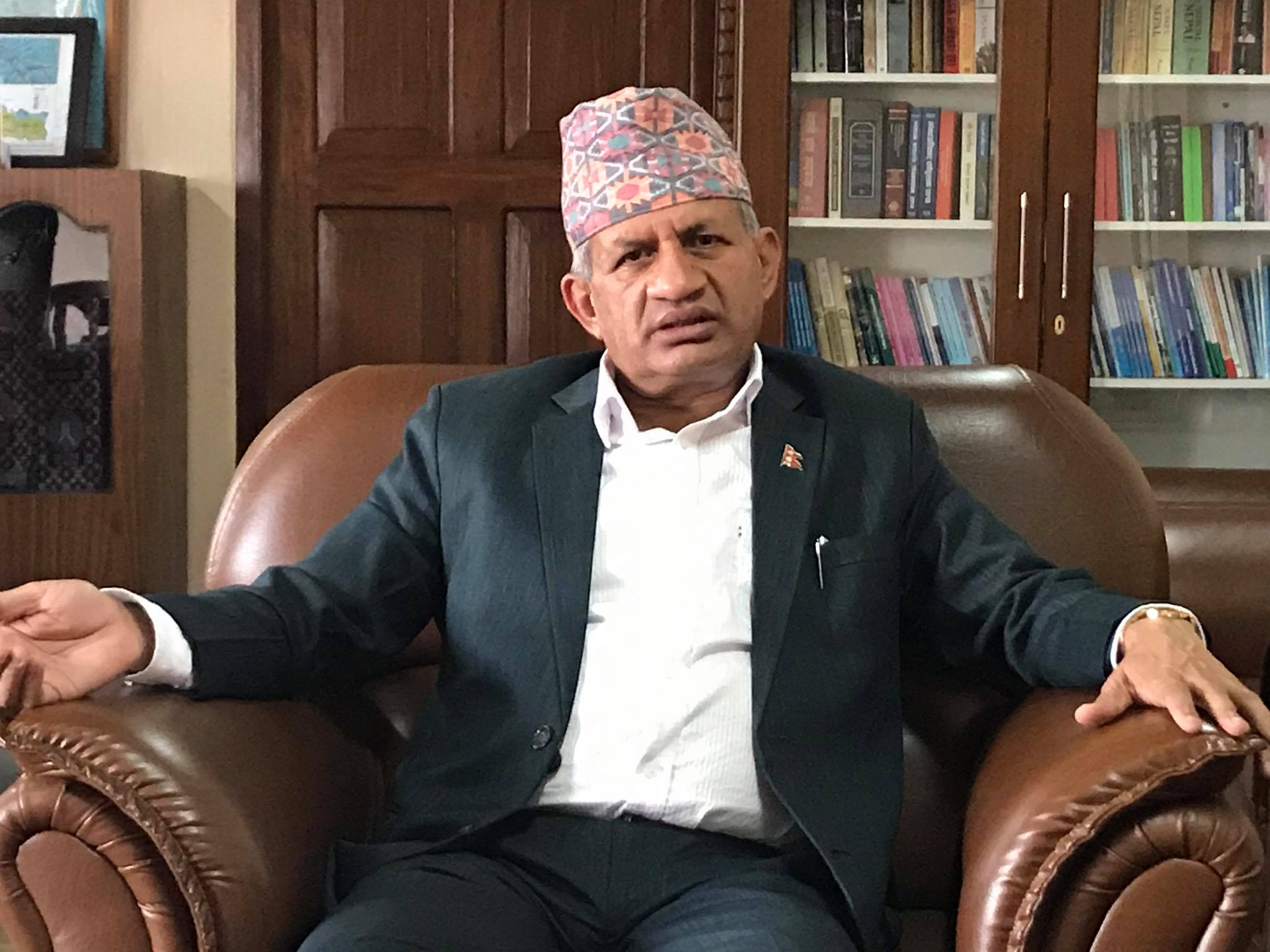
What if India does not want to resolve the issue?
We have not thought of the alternatives. We are confident that this issue will be resolved via bilateral talks. We are confident that India will accept the historical facts. I want to tell our Indian friends that this is a baggage left by history. And so I request them to be not so possessive about this.
Nepal and India have unique and close relations. We are interdependent, interconnected. We should accept this reality. We want a relation based on sovereign equality, mutual respect, and mutual benefit.
Countries are small and big. But this does not determine a country's sovereignty. All nations are equally sovereign.
Nepal is not a threat to India; be it culturally, economically or security-wise. We want to live in harmony. We request the Indian side to understand this and leave aside the prejudices. We have to accept the historical facts.
Compared to India’s outstanding border disputes with other countries, the dispute with Nepal is the easiest one to resolve. It is easy for India to resolve this issue with Nepal.
Nepal makes its own decision, and is not dictated to anyone. And we do not respond to threats. If we all understand these facts, we can resolve the border issue.
Has Nepal thought of a time frame for bilateral talks?
I had requested my Indian friends to sit for talks and initiate a diplomatic procedure after they issued a political map on November 2, 2019 so that the people, and even the media would focus on talks. If we do not sit for talks, then people speak out. Some Indian friends had told us about the protests in Nepal.
And there is this rhetoric that “anti-Indian sentiment” has increased in Nepal. I do not believe in this. India should also be aware of Nepal’s sensitivities. We welcomed Indian PM Modi in 2014 with a big heart. We deeply appreciated India’s first response in the aftermath of the 2015 earthquakes. Be it in Janakpur, Muktinath or in Kathmandu’s City Hall, PM Modi was received with fanfare.
Nepal complains when someone questions her sovereignty. It hurts Nepal when someone questions her sovereignty. We do not want to prolong the border issue. It will only provide a space to those bent on spoiling our relations. Instability is not beneficial to both the countries.
We are all fighting against the corona pandemic. We cannot predict the world in the aftermath of this pandemic.
If we are not ready to sit for talks, it will not help us. We are ready to sit for talks.
Have we activated different formal and informal channels to initiate a dialogue with India?
We are communicating via formal and informal channels. We are fully confident that the two countries will resolve the border issue by peaceful means. Our moves are not reactive. After initial efforts did not yield results, we made the move based on all the evidence at our disposal.
We do not have geo-political ambitions. We need to work in good faith, and not question our motive. We have to respect the idea of sovereign equality, and have to accept the facts, and the truth.
We should look to the future. This is Asia’s century. India and China are huge players. We feel lucky to be in the middle of these great powers. We take this as an opportunity, and we can leapfrog if we can connect to their economies.
However, despite our size and economy, no one should take us for granted.
Nepal and India were coordinating on fight against the pandemic before Nepal issued the new map. Will the new development impact our coordination to fight against the coronavirus?
I hope it won’t. Our debate on history’s pending issues is still out there, but the main challenge now is to fight against the virus.
We have millions of Indians and Nepalis living and working across our borders. It is not true that millions of Nepalis live and work in India, but none of their people live and work here. The numbers are almost the same.
In terms of remittances, India takes three times what Nepal brings in from India. We are the seventh largest source of remittances to India. Thousands of Nepalis are in India, and vice versa. Citizens of both countries want to return home, and that is their rights. But it is a shared responsibility of both the governments to support and help foreigners stuck in their respective countries.
Nepal is working in full faith, despite our shortcomings. We are providing basic services to Indians and others stuck in Nepal. We expect the same from India as well.
We believe that our border disputes should not and will not have ramifications in our fight against coronavirus.
Some reports say that thousands of Nepalis are being sent to Nepal. Is it true?
I do not believe this is a deliberate move. India has been trying to help millions of its people to go to their home states. Railway services were resumed. And Nepalis also took the opportunity to come to our borders. It is now a new challenge for us.
Those in India want to return home, and that is understandable. I do not believe there is a political motive behind the upsurge of Nepalis returning home.
Are we struggling to balance our relations with India and China?
I think it's all based on issues. I am happy with the way our relations have developed with both India and China. After a low point during the blockade, we have entered into a new phase of development partnership with India. Indian PM Modi visited Nepal four times during his first tenure. PM KP Sharma Oli visited India twice in his second tenure. The projects that were pending for years, including the Arun III and the Postal Highway, the Integrated Check Post, the post-earthquake reconstruction works, have been expedited. South Asia’s first cross-border pipeline has been inaugurated. Works on cross-border railways and waterways, the Kathmandu-Raxaul railways, and partnerships in agriculture have been initiated.
Nepal and China signed a transit trade treaty in 2016, and the protocol was signed. Our transit facility has been diversified, and we are now land-linked. Nepal and China have termed the new relationship as a strategic partnership for development and prosperity.
However, we have outstanding issues. History has left us some unfinished works. The Eminent Persons’ Group (EPG) was formed in 2016, and the joint team produced a consensus report. If we accept the report and implement it, a lot of our bilateral issues will be resolved. I am not sure why there is some reluctance on India’s part to receive the report.
Nepal was lost in transition for many years. We had lost our space and voice in the international stage. Our genuine concerns were not heard. In the changed political context, Nepal has expanded her image and space. It is bound to make a difference in the traditional power structure.
I believe we have not, and will not, pivot from maintaining excellent relations with both of our neighbors.
You May Like This
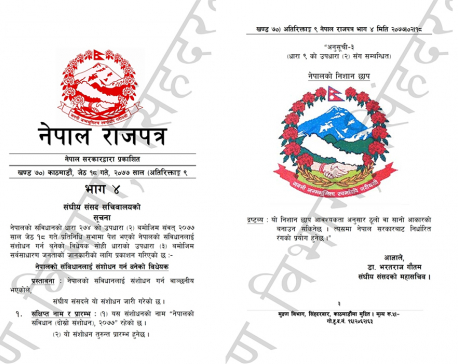
Constitution amendment bill on the new map published in Nepal Gazette for public information
KATHMANDU, June 1: The constitution amendment bill on the new political map of the country tabled earlier in the federal... Read More...
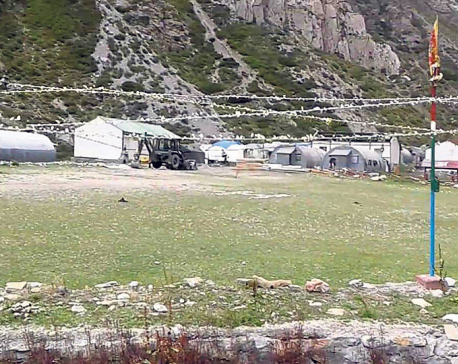
Issue new map comprising Indian-encroached areas: House panel
KATHMANDU, Dec 14: The International Relations Committee of the parliament has directed the government to issue a new political map... Read More...
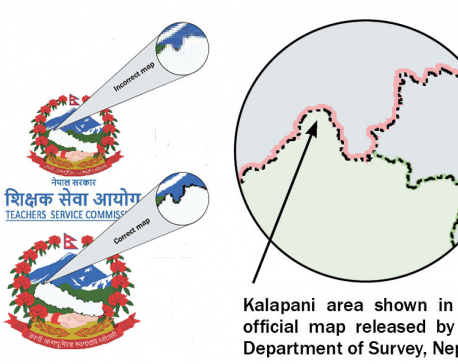
Reissue Nepal's map that includes Limpiadhura: House committee directs govt
KATHMANDU, Nov 12: The State Affairs Committee (SAC) of the House of Representatives (HoR) has directed the government to issue a... Read More...







Just In
- NRB to provide collateral-free loans to foreign employment seekers
- NEB to publish Grade 12 results next week
- Body handover begins; Relatives remain dissatisfied with insurance, compensation amount
- NC defers its plan to join Koshi govt
- NRB to review microfinance loan interest rate
- 134 dead in floods and landslides since onset of monsoon this year
- Mahakali Irrigation Project sees only 22 percent physical progress in 18 years
- Singapore now holds world's most powerful passport; Nepal stays at 98th











Leave A Comment